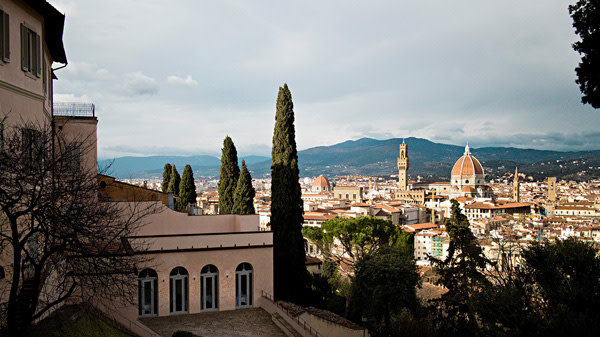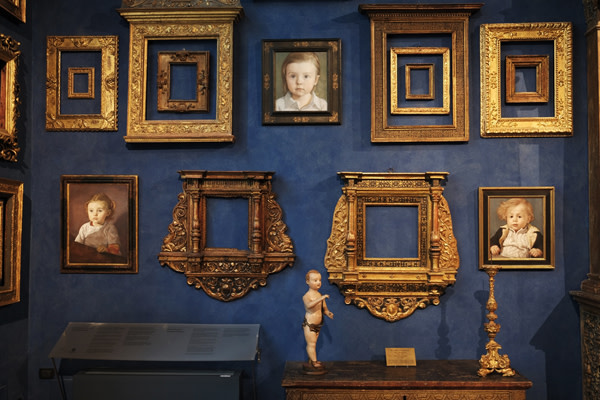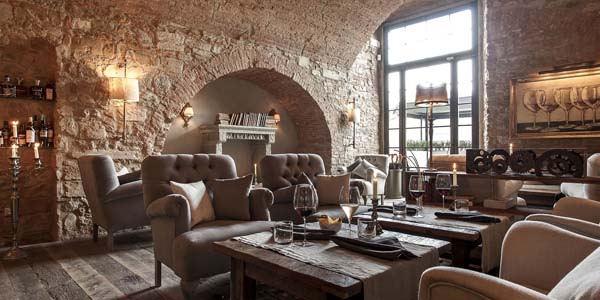Welcome to San Niccolò district
A journey through time along a neighborhood made up of history and uniqueness. Discovering his must-see
Spectacular gardens, flower-clad hills, panoramic views and sunsets over the Arno. San Niccolò is the ideal district for those wishing to take break from everyday life and admire Florence from a unique position.
Its special charm derives from a combination of imposing medieval and Renaissance palaces, modest houses, food stores, small boutiques, art galleries and hip restaurants and coffee bars. It is a magical and iridescent quarter, whose tranquil village-like atmosphere changes when its nightlife begins. Our stroll starts at Ponte Vecchio. Once across it, we enter Via Guicciardini and see on our left Piazza Santa Felicita, a vivacious square with outdoor restaurants and wine bars which reveals a more authentic side of Florence.
 Florence view from Villa Bardini
Florence view from Villa BardiniFrom this square we can take Costa San Giorgio, a charming street which runs along ancient walls. The steep steps called Rampa delle Coste will come into view on the left. They lead down to Piazza di Santa Maria Soprarno, which offers a timeless atmosphere and where everyday routines seem almost sacred and unchangeable.
Taking a stroll along Via de’ Bardi means retracing the steps of Beatrice, the woman Dante idealized and who married Simone de’ Bardi. On the left side of the street, at number 36, we can stop to admire Palazzo Capponi delle Rovinate. Its name derives from the hill behind it, subjected to landslides (‘rovinate’ means ruined) in ancient times. Not to be missed nearby is the house of Galileo Galilei, on Costa San Giorgio. Attached to the back side of the building is a sundial, personally constructed by the famous astronomer. An archway over the street will tell us we have reached the old city gate, Porta San Giorgio. Once on the opposite side, we can see on our right Forte Belvedere, which affords lovely views over Florence. This fort was designed by Bernardo Buontalenti in the late 16th century for Ferdinand I de Medici.
 Bardini Museum, Firenze
Bardini Museum, FirenzeAt this point we are on Via San Leonardo, a narrow picturesque street flanked by old stone walls that leads out of the city and towards the countryside. We will be walking past the Florentine campus of the John Hopkins University, the Church of San Matteo in Arcetri, the studio of the painter Ottone Rosai and the Florentine home of Tchaikovsky.
On our way back we can stop at the Museo Bardini in Piazza de’ Mozzi, located at the western end of Via San Niccolò. The Museum takes its name from the man who created it, Stefano Bardini, the most important Italian antiquarian. After years of intense work in his field, he decided to transform his collection into a museum and donate it to the City of Florence. Today the Museum gathers over 2000 pieces, consisting of sculptures and paintings, mostly dating from the Middle Ages and the Renaissance, and 18th-century design objects. One of the most charming secret gardens of Florence are no-doubt the ones at Villa Bardini.
A stroll through these gardens allow us to enjoy their silent beauty and discover the Baroque staircase, at the top of which there is a loggia. From here, the views are breathtaking. Other features are decorated fountains, grottoes, statues, a small theater created by hedges and many different kinds of flowers: roses, irises and hydrangeas. We now take Via San Niccolò, walking in the direction of the Church of San Niccolò in Oltrarno, whose sacristy houses a tabernacle attributed to Michellozzo.
Standing to the right of this church is Porta di San Miniato, designed by Arnolfo Di Cambio and considered the heart of the San Niccolò quarter. Knocked down during the 1966 flood, it was recovered, restored and rebuilt where we see it today. This corner of the city owes its fame to artists and men of literature and is today a favorite hang out of locals and foreigners. Porta San Niccolò, built in 1324, is situated a little further ahead. It is the only city gate in Florence whose height has not been altered. We are now standing before the Museum House of Rodolfo Siviero, once home of a passionate collectionist nicknamed “the James Bond of art”.
But the neighborhood not only lends itself to enjoying the romantic side of Florence, but also discovering a slow-paced way to explore the city. Highly-recommended is a walk along the pathway that begins in Piazza Giuseppe Poggi and meanders uphill towards Piazzale Michelangelo. It was designed by Poggi, who transformed the entire hill between 1867 and 1876, when Florence was capital of Italy.
Fountains and rest areas shaded by century-old trees will make for a most delightful stroll, which will allow you to take in the magnificent views over the city. Standing in the center of the Piazzale, a must site for every tourist, the bronze copy of Michelangelo’s David looks out over the city and the hills beyond. Here are a few places you should not miss while exploring this quarter.
Let us begin with Stefano Bemer, a world-renowned brand of bespoke high-end shoes. Their new workshop is housed inside a church dating from 1439, located on Via San Niccolò. On the same street, Alessandro Dari creates his jewelry inside the ancient Palazzo Nasi-Quaratesi. A workshop-museum since 2001, the Palazzo houses over 900 creations by the artist. Ironic and a nonconformist, his street signs add a contemporary touch to such an ancient city as Florence. We are talking about the French artist Clet Abraham, who established his studio in the San Niccolò quarter.
 Borgo in the City Restaurant
Borgo in the City RestaurantLook for it at number 8 of Via dell’Olmo. Our food chapter begins with what is currently two of the top gourmet restaurants in Florence: Borgo Santo Pietro in the City. This oasis of fine taste consists of the Bottega del Buon Caffè (1 Michelin star restaurant), the Lounge Wine Bar and the Enoteca Wine Shop. Inside the magnificent Villa Bardini a place where art and food create a truly unique combination, we are at La Leggenda dei frati, 1 Michelin star.
The common denominator is the traditional Florentine style, but combined with a refined urban-chic flair. Another high-end restaurant is San Niccolò 39 (on Via San Niccolò), also known as SO39. Located near the foot of the staircase leading up to the Giardino delle Rose, to Piazzale Michelangelo and to San Minato, is the Enoteca Fuori Porta, which serves traditional dishes, such as the classic crostoni (large slices of roasted bread with toppings), and good wines. Hamburger lovers, but Tuscan Style, will opt for Lungarno 23. Located on Piazza dei Rossi, which can be reached by walking along Costa San Giorgio, Le volpi e l’uva is the place to go if you like your aperitif served with lots of finger-food, which this busy eatery has been known for for over twenty years (also open at lunch). Top quality at a reasonable price is the philosophy here. Over forty wines from small Italian, French and Spanish producers served by the glass. Those looking to enjoy Tuscan fare in a homey atmosphere will choose La Beppa Fioraia. Defining features: shabby chic decor and an enchanting location, next to Piazzale Michelangelo. On another but not completely unrelated topic, San Niccolò is also an extremely popular happy hour destination. The best places? Il Rifrullo, on Via San Niccolò, and Zoe and Negroni, both on Via dei Renai. Now you’re all set.









